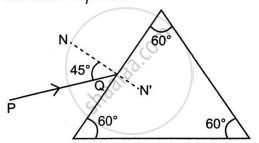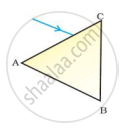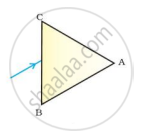Advertisements
Advertisements
Question
Explain the phenomenon of dispersion of white light through a glass prism, using suitable ray diagram.
Solution
Splitting of light into its constituent colors is referred to as dispersion. When a narrow beam of white light falls on a triangular glass prism, the light of different colors have different refractive indices in the glass. However, the speed of light is the same irrespective of its colors. Different refractive indices of different colors of light lead to their different bending pattern. This causes splitting of white light into light of seven colors called as VIBGYOR. V= violet, I= indigo, B=blue, G=green, Y= yellow, O=orange, R=red.

The light of red color bends the least on passing through the prism and appears at the top while violet color bends through the maximum angle and appears at the bottom.
APPEARS IN
RELATED QUESTIONS
The deviation produced by a prism is independent of the angle of incidence and is same for all the colours of light.
A light ray of yellow colour is incident on an equilateral glass prism at an angel of incidence equal to 48° and suffers minimum deviation by an angle of 36°.
- What will be the angle of emergence?
- If the angle of incidence is changes to (a) 30°, (b) 60°, state whether the angle of deviation will be equal to, less than or more than 36°?
Which of the two prism, A made of crown glass and B made of flint glass, deviates a ray of light more?
How does the angle of deviation depend on the refracting angle of the prism?
A ray of light is normally incident on one face of an equilateral glass prism. Answer the following:
What is the angle of refraction from the first face of the prism?
A prism ABC (with BC as base) is placed in different orientations. A narrow beam of white light is incident on the prism as shown in below Figure. In which of the following diagrams, after dispersion, the third colour from the top of the spectrum corresponds to the colour of the sky?
How will you use two identical prisms so that a narrow beam of white light incident on one prism emerges out of the second prism as white light? Draw the diagram.
The diagram below shows the path of a blue ray through the prism:
- Calculate the critical angle of the material of the prism for blue colour.
- What is the measure of the angle of this prism (A)?
- Which colour should replace the blue ray, for the ray to undergo Total Internal Reflection?

A monochromatic ray of light is incident on an equilateral prism placed at minimum deviation position with an angle of incidence 45° as shown in the diagram?
- Copy the diagram and complete the path of the ray PQ.
- State two factors on which the angle of deviation depends.

Name the colour of white light which is deviated the least on passing through a prism.




